|
|
|||||
| home > sopralluoghi | |||||
| I
would prefer (not to...) "Spot on... architecture Sicily south-east" Andrea Guardo |
|||||
|
Spot
on... architecture Sicily south-east |
|||||
| [in
italiano] |
With
our feet firmly placed in the fashion statements boulevard and still
bombarded with loads of mediatic messages, we are invited to think about
Sicily as a "land in a sea of light", this is what appears on familiar
adverts in various domestic airports thus inviting potential travellers
and visitors. Next to a tradition of cultural tourism that now everyone,
in his own right or wrong, is effortlessly promoting, we are now starting
to think about sponsoring a new local product that relates to artistic
production or architecture as an opportunity to create happenings. Thus
abandoning the cream of the crop and sometimes rotten environment
of academia and institutions, there comes a chance to create occasions
for meetings with a growing audience by means of friendly situations
that aims at transmitting non-familiar message.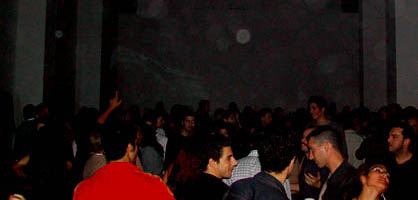 "Spot on... architecture Sicily south-east" represents an attempt to have fun and to show a different aspect of the Faculty of Architecture to a city that sometimes has proved to be sleepy and indifferent to it. Siracusa lies in the middle of the Mediterranean sea, however it struggles to get rid of its peripheral appearance. It is not capital as Palermo nor busy as Catania, however it is shriving to invent itself a profile of "festival city", a showcase for public events along with a well-established tradition in cultural tourisms. Two young institutions are the actors of this happening. These are the Faculty of Architecture, that is running on its seventh year since its setting up, and the Montevergini Civic gallery of Contemporary Art, the one and only contemporary art gallery in Sicily and one of the very few in the southern area of Italy. This event sets the premises for further initiatives that would ultimately promote a permanent cultural dimension in a city that remains a character looking for characterization. Far from being another nostalgic celebration of an ancient city that undoubtedly is the witness of a glorious archaic multicultural heritage, this event focus its spotlights on what is contemporary and not yet time-honoured. |
[28jan2003] | |||
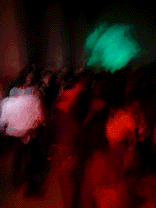 |
It
is necessary to breakthrough into wider cultural areas by means of spectacular
events, because these are those occasions that, in the future, will
be able to attract audience and, most of all, those who are less informed
and somehow new to such events. Nevertheless, we are perfectly aware
that it is necessary to avoid the show in the way Debord would consider
it. Popular festivals, especially those relating to tradition and religion,
are certainly spectacular. They represents the liveliness of a town,
and this is that kind of engagement that is gradually pursued by programming
events that will be considered as regular, such as the Ortigia
Festival that has managed to act as catalyst to involve the whole
town in street festivals. Which are the ingredients of "Spot on"? It is an exhibition set for a couple of hours and a happening as an opportunity to exchange experiences and laughs, opinions on the assignment that the students of the school of architecture have carried out. The Faculty "tribe" longs to gather, once again, far from the institutionalized roles that guide the day-to-day work routine. Last but not least, the Civic Gallery of Contemporary art, and precious and kind collaboration of director Salvatore Lacagnina, acting as host for the venue that had opened up its spaces to its guests in that informal way that characterizes the management of this young institutions. The Gallery spaces build a route linking different target areas, to offer different situations, activities as well as places to stop and gather: the first impact is with slideshow presentations prepared by students. The analysis of transformation occurring to meaningful places of the city constitutes the red-line guiding the descriptions of sites that bear great potentials within the major transformation programs investing Siracusa: these are the areas where the ancient and the modern city meets the sea, namely the Small port and the Great port. Dimitri Liakatas, Cristina Crapanzano and Eliana Fischer work is focused on the description of "time" in relation to these places; this is intended to build an archive of site-samples from the Small Port that are illustrated through a simple yet intense narration, whereas the groups of Emanuela Timpanaro, with Laura Vinci, Stefano Scordino, Nicoletta Di Marco and Giovanna Cammarata with Daniela Martines, Andrea Todaro have developed different readings on the Great Port by concentrating the attention on its different components as structuring a layered system. |
||||
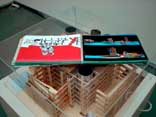 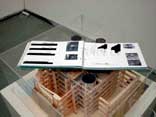 |
These
areas have been the focus of the two editions of the International
design workshop promoted by the Faculty of Architecture. The design
of the "limit" focused participant's and visiting professors Francesco
Cellini, Manuel Aires Mateus and Luigi Snozzi, on suggestions regarding
the Talete promenade in Siracusa. The appropriateness of the car-park
infrastructure is the main question arising from the debate and the
value of its demolition relates to the possibility of redefinition of
the city edge with the sea, ultimately improving the quality of its
urban spaces. The great port is the focal point of several design exercises
within faculty courses, and sites the thesis proposals of the first
graduates supervised by the Dean prof. Ugo Cantone; these works have
also been displayed in Venice on the occasion of the Biennale d'architettura
2002, and again the core of Gonçalo Byrne, Tony Fretton, and Ugo Cantone
proposals within the second edition of the international design workshop. The "spotlight" shines on the student's interpretations of the territory in transformation as a result of plans, urban policies and strategies but, most of all, as a consequence of architecture which is not analyzed, in this particular case, under the design profile, instead as a fundamental part of the analytical reading process. The exhibition route leads inside the great hall of the Gallery, the former church of Montevergini, that works as plenum for the crowd of people assembling here only to move to other destinations. On one side of the hall images from films Frankenstein and Frankenstein junior mixed up with rising rhythms of music that sets another gathering device. The performance is not unplanned at all: the narration of dismantled, reassembled and brought back to life body-parts represents a metaphor explaining a conceptual strategy on town planning. This idea introduces to the final part of the exhibition, where the visitors will experience a show of faces and architectures.Faces of students, professors, clerical staff, crowd the day-today life of the university, they represents a constant presence in the seven years of the faculty life. The faces are the corporal components that inhabit the city and architecture, these are familiar features, sometimes posing or spontaneously framed, built into a sequence of images that was mounted by student Claudio Patanè. The photographs creates the structure for a slideshow of architectures, cities, territories: Riesi, Salemi, Gibellina, Sciacca, Palermo and also Buccheri, Palazzolo, Vittoria, Floridia that are the itineraries within the traveling lectures. Blurred photos refuse to show the traditional character references of Sicily as relating to a well-established and triumphal grand tour traditions, whilst, instead, they hold on recalling "other" objects that occupy the south-eastern Sicilian landscapes and that make up the skyline of contemporary territory. Some images are distracted and vague, almost indifferent to architecture on its own, whilst the interest is focused on fragments, details that seems to have been separated through surgical procedure from its surroundings. There is no need for celebrating this or that design solution, instead there is great attention to analysing a contest through a non-univocally pre-determined procedure, as if the spectators were the witness of a Chinese shadows show, where the shapes are displayed their contours in a clear or blurred way, similarly to objects reflecting on the water surface and distorted... |
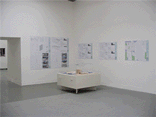
|
|||
| The
structure of the final part of the performance is probably the most
noteworthy and effectively supported by the sophisticated drum & base
sound mixed by student-dj Marco Tripi, who created the fabric for a
self-structured presentation of visual materials. The performance has
laid the bases for students to express themselves through different
medias and ways. So far so good! It's not up to us to give "grades" to the event, this is not the idea behind the paper, nor advertising or declaring the for and against to someone or something... I believe, instead, we should me more sensible to those who demand more opportunities... I would prefer to have more spot-on events, possibly pertaining to other themes or cultural fields... I would prefer to have alternatives... I would prefer... Andrea Guardo andrea.guardo@libero.it |
|||||
|
Per
qualsiasi comunicazione laboratorio
|
|||||